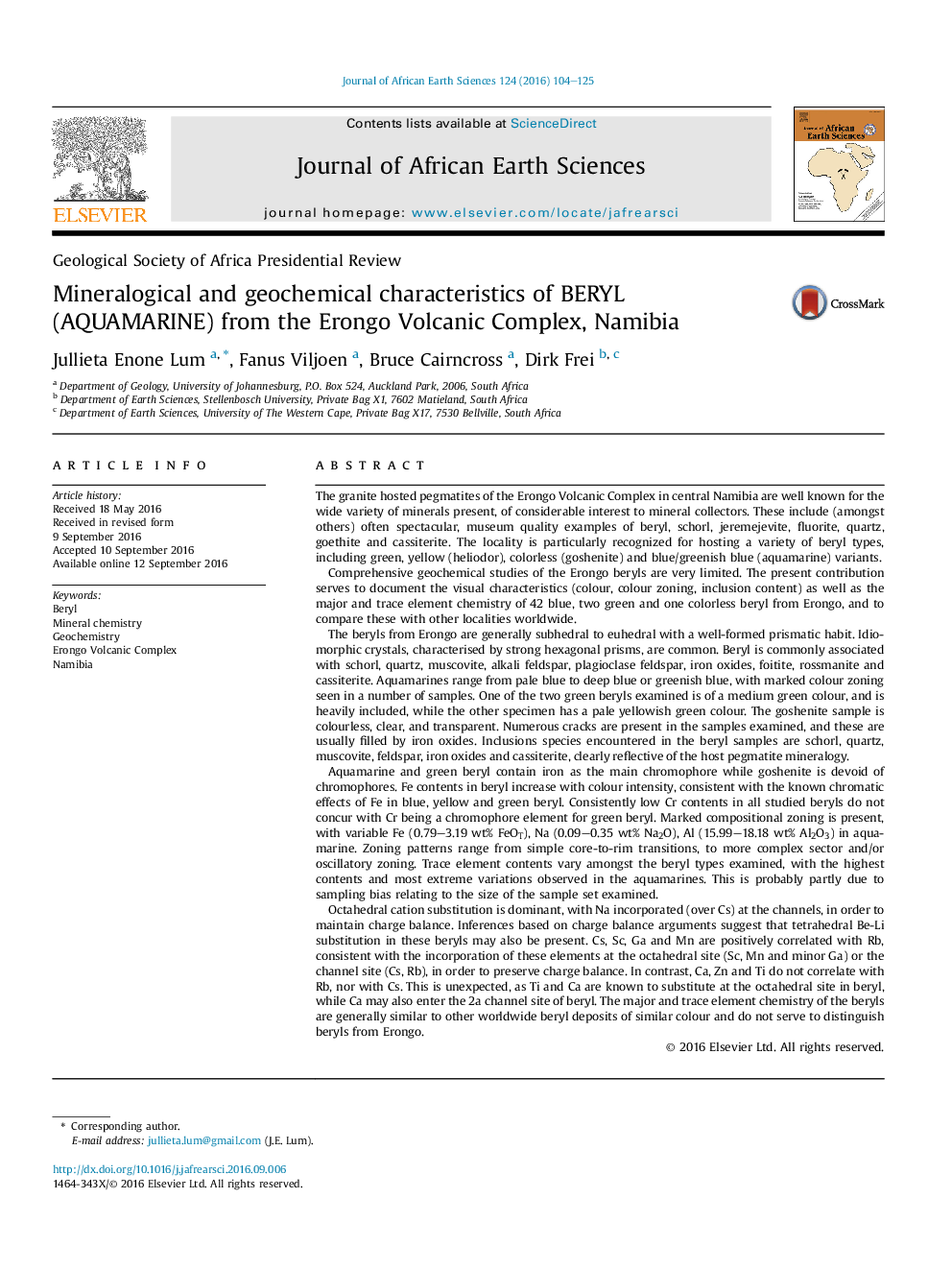| کد مقاله | کد نشریه | سال انتشار | مقاله انگلیسی | نسخه تمام متن |
|---|---|---|---|---|
| 4728134 | 1640184 | 2016 | 22 صفحه PDF | دانلود رایگان |
• A combined visual, microscopic and geochemical study of beryls from Erongo in Namibia.
• Compositional heterogeneity is common in single specimens as observed in backscatter and chemistry of various zones.
• No distinctive locality-specific chemistries are observed in investigated beryls.
The granite hosted pegmatites of the Erongo Volcanic Complex in central Namibia are well known for the wide variety of minerals present, of considerable interest to mineral collectors. These include (amongst others) often spectacular, museum quality examples of beryl, schorl, jeremejevite, fluorite, quartz, goethite and cassiterite. The locality is particularly recognized for hosting a variety of beryl types, including green, yellow (heliodor), colorless (goshenite) and blue/greenish blue (aquamarine) variants.Comprehensive geochemical studies of the Erongo beryls are very limited. The present contribution serves to document the visual characteristics (colour, colour zoning, inclusion content) as well as the major and trace element chemistry of 42 blue, two green and one colorless beryl from Erongo, and to compare these with other localities worldwide.The beryls from Erongo are generally subhedral to euhedral with a well-formed prismatic habit. Idiomorphic crystals, characterised by strong hexagonal prisms, are common. Beryl is commonly associated with schorl, quartz, muscovite, alkali feldspar, plagioclase feldspar, iron oxides, foitite, rossmanite and cassiterite. Aquamarines range from pale blue to deep blue or greenish blue, with marked colour zoning seen in a number of samples. One of the two green beryls examined is of a medium green colour, and is heavily included, while the other specimen has a pale yellowish green colour. The goshenite sample is colourless, clear, and transparent. Numerous cracks are present in the samples examined, and these are usually filled by iron oxides. Inclusions species encountered in the beryl samples are schorl, quartz, muscovite, feldspar, iron oxides and cassiterite, clearly reflective of the host pegmatite mineralogy.Aquamarine and green beryl contain iron as the main chromophore while goshenite is devoid of chromophores. Fe contents in beryl increase with colour intensity, consistent with the known chromatic effects of Fe in blue, yellow and green beryl. Consistently low Cr contents in all studied beryls do not concur with Cr being a chromophore element for green beryl. Marked compositional zoning is present, with variable Fe (0.79–3.19 wt% FeOT), Na (0.09–0.35 wt% Na2O), Al (15.99–18.18 wt% Al2O3) in aquamarine. Zoning patterns range from simple core-to-rim transitions, to more complex sector and/or oscillatory zoning. Trace element contents vary amongst the beryl types examined, with the highest contents and most extreme variations observed in the aquamarines. This is probably partly due to sampling bias relating to the size of the sample set examined.Octahedral cation substitution is dominant, with Na incorporated (over Cs) at the channels, in order to maintain charge balance. Inferences based on charge balance arguments suggest that tetrahedral Be-Li substitution in these beryls may also be present. Cs, Sc, Ga and Mn are positively correlated with Rb, consistent with the incorporation of these elements at the octahedral site (Sc, Mn and minor Ga) or the channel site (Cs, Rb), in order to preserve charge balance. In contrast, Ca, Zn and Ti do not correlate with Rb, nor with Cs. This is unexpected, as Ti and Ca are known to substitute at the octahedral site in beryl, while Ca may also enter the 2a channel site of beryl. The major and trace element chemistry of the beryls are generally similar to other worldwide beryl deposits of similar colour and do not serve to distinguish beryls from Erongo.
Journal: Journal of African Earth Sciences - Volume 124, December 2016, Pages 104–125
